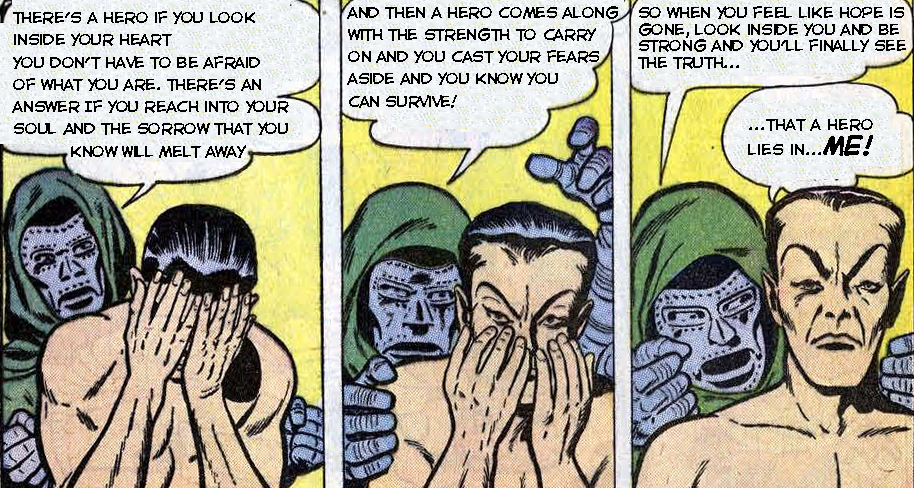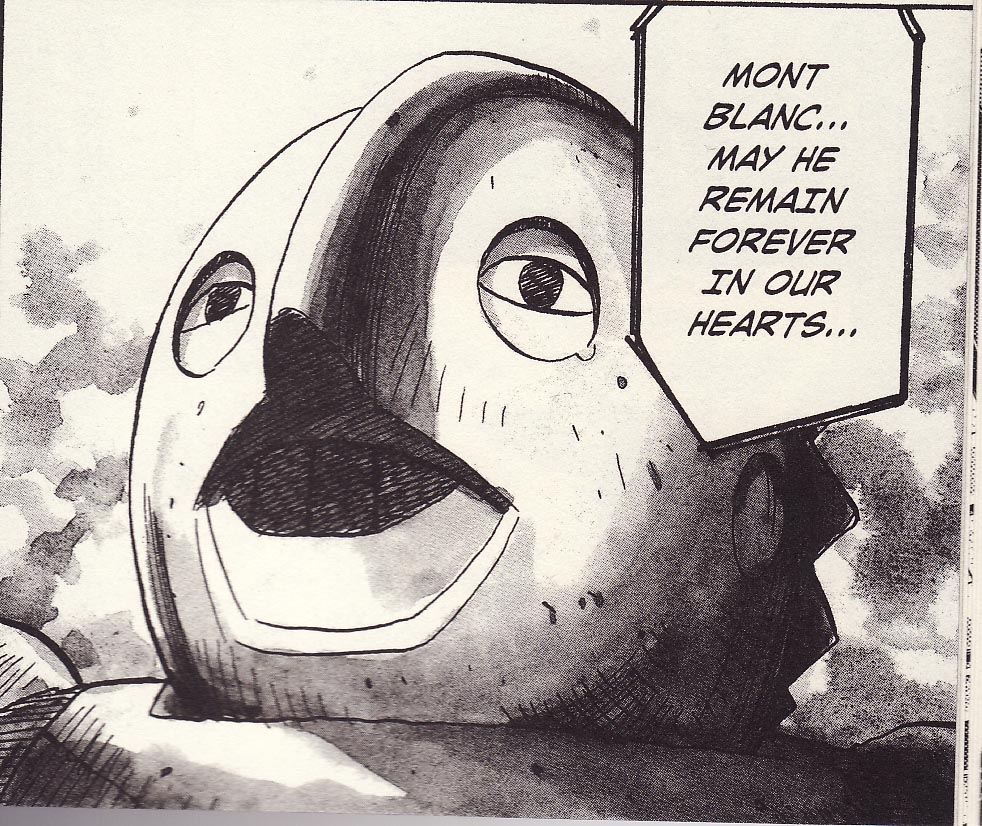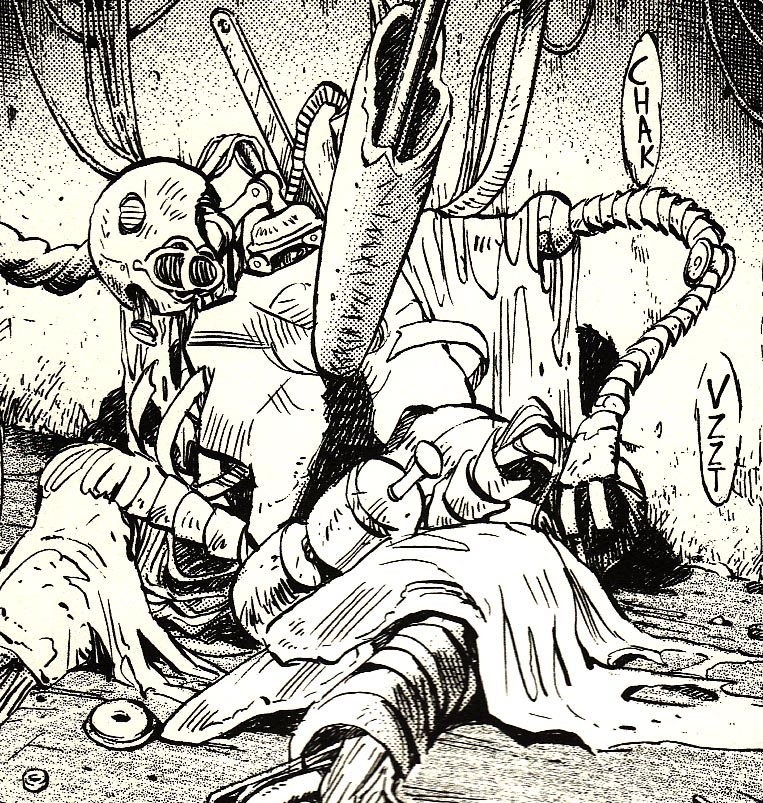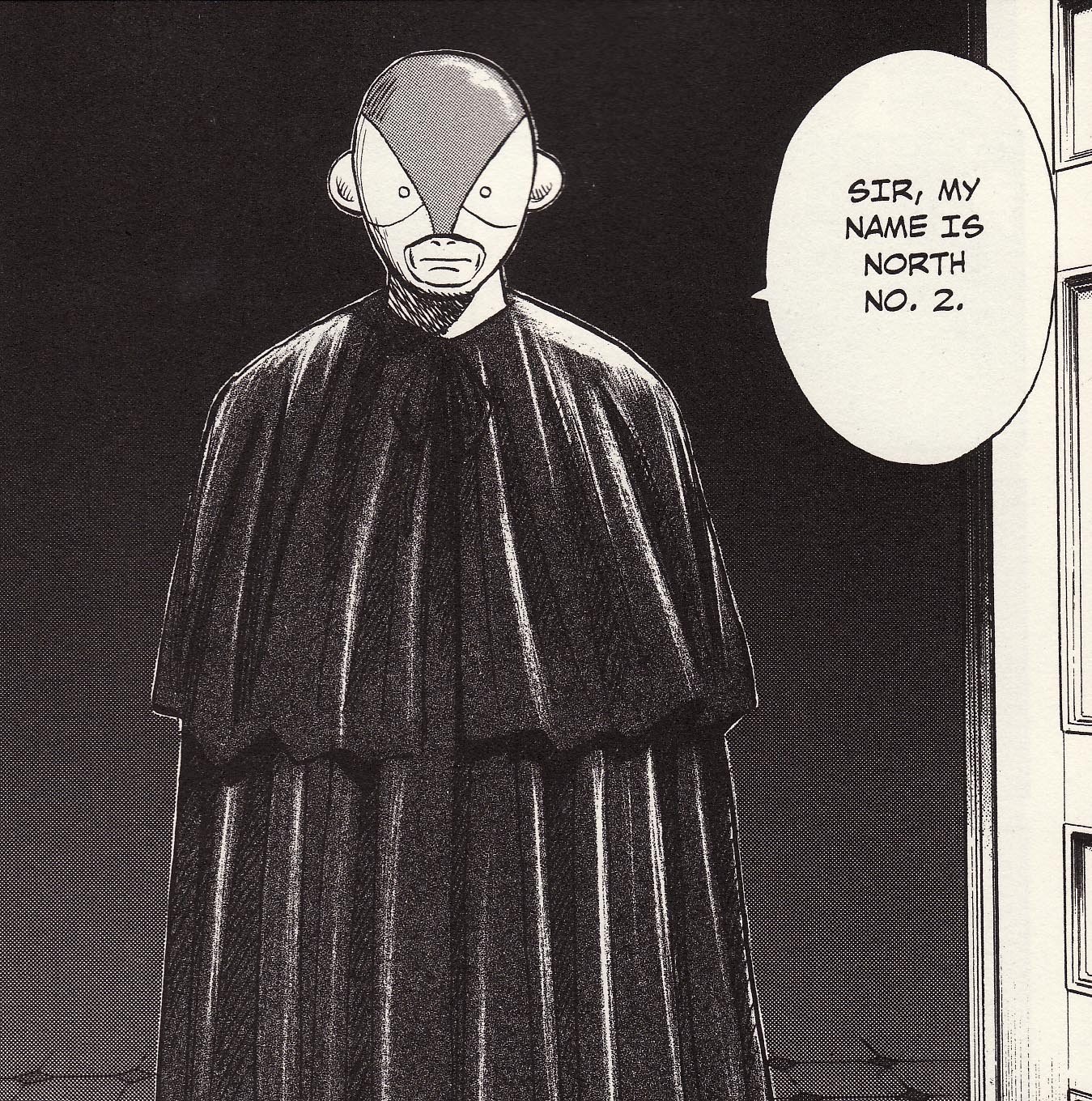Oracle: The Cure No. 2
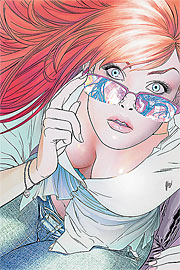 Hmm. I'm not too sure about this series. I mean, it's basically Oracle vs Calculator, which was among the best subplots of Birds of Prey, but this Oracle isn't quite as interesting. Maybe it's the fact that this is a distinct series - some of the character that was built up over the course of n issues had to be discarded in order to keep people who didn't read those issues but are following Battle for the Cowl in the loop. So Oracle spends some time being stoic about her paralysis and gets mugged and kicks the muggers asses and gets mistaken for an agent of the real/male Oracle. It makes me wish that this were just a crossover sneaking into a series that I read, much as I normally dislike that.
Hmm. I'm not too sure about this series. I mean, it's basically Oracle vs Calculator, which was among the best subplots of Birds of Prey, but this Oracle isn't quite as interesting. Maybe it's the fact that this is a distinct series - some of the character that was built up over the course of n issues had to be discarded in order to keep people who didn't read those issues but are following Battle for the Cowl in the loop. So Oracle spends some time being stoic about her paralysis and gets mugged and kicks the muggers asses and gets mistaken for an agent of the real/male Oracle. It makes me wish that this were just a crossover sneaking into a series that I read, much as I normally dislike that.
Eh, it's an okay book. Honestly, the whole Battle for the Cowl thing has been okay so far: better than the average crossover if not as good as a well-written regular series. Cons: lots of cheesecakery (yes yes: some of you will consider this a pro, but if I want that I'll go looking for it) and the whole thing seems like it was written by someone who doesn't know as much about the Internet as prior Oracle scribes. Babs Gordon having to look up who Charles Babbage is? Not knowing what the DCU equivalent of Second Life is? Ha.
The Phantom: Generations No. 1
 The Phantom appeals to me in theory: line of adventurers stretching back hundreds of years and doling out justice in a purple union suit, whoopee! So much to read, so little time, though: the only time that I've ever read the Phantom was as a part of a 1980s team called Defenders of the Earth, with Flash Gordon and Mandrake the Magician, I think. Their battle cry wasn't "Liscenced Properties Assemble!" but it should have been.
The Phantom appeals to me in theory: line of adventurers stretching back hundreds of years and doling out justice in a purple union suit, whoopee! So much to read, so little time, though: the only time that I've ever read the Phantom was as a part of a 1980s team called Defenders of the Earth, with Flash Gordon and Mandrake the Magician, I think. Their battle cry wasn't "Liscenced Properties Assemble!" but it should have been.
Anyway, this series looks intriguing - actually, a lot of Moonstone's upcoming stuff does (okay, not all of it. MILF Magnet?). The first issue takes the form of entries from the very first Phantom's journal with accompanying pictures. The art (let's see... Pat Quinn) is good stuff - it'll be interesting to see it in a panel-based format, if that's the way they go with later issues. The writing (Ben Raab) turned out to be good. I wasn't sure at first, as the early pages are slightly drowned in archaicisms. Also, there's a big Norseman with a halberd and no attempt was made to de-bright-purple the Phantom's suit, which I appreciate. I'll be picking up No. 2, if that means anything. (huh. Turns out that there is a whole Phantom series out already by Moonstone. How'd I miss that?)
American McGee's Grimm No. 1
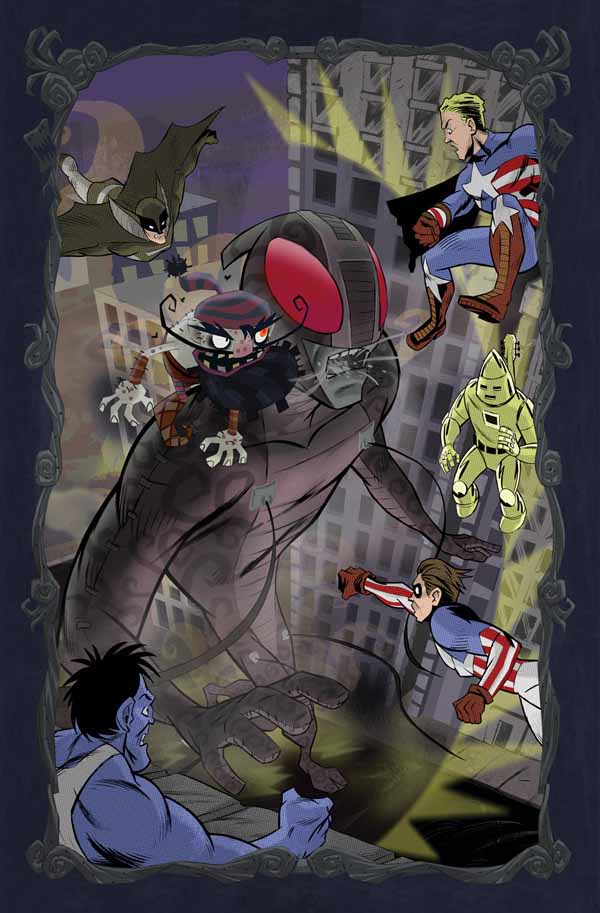 I know next to nothing about American McGee. I don't, for example, know whether he is the one that sticks his name in front of the titles of his projects. Heck, I haven't even played any of his games. Well, we had a copy of American McGee's Alice when I was in university but nobody had a computer that would play it unless we turned the graphics down to Virtua Fighter levels, which detracted from the dark reimagining. Anyway, it's a shame that all I have to judge him by is this comic. Heck, he didn't even write it (unless he is also this "Dwight L. MacPherson", possibly for tax reasons). Bah. I know that it's a tie-in to a video game (to the extent that the Grimm character gets what look to be in-game hints throughout the comic) but that's no excuse. From what I gather, American McGee's Grimm is about taking the happy-go-lucky fairy tales of today back to their gross and violent roots. This is an interesting concept, I admit. BUT! It is neither interesting nor clever to then try to do the same thing to comic books by essentially ignoring anything that has happened artistically or naratively in the last forty years. Grimm drops into a meeting of Sixties-esque villains and makes them dark and spikey and then takes them off to kill super-heroes. That is not subversive, Grimm - that is what we call The Early Nineties. Bah.
I know next to nothing about American McGee. I don't, for example, know whether he is the one that sticks his name in front of the titles of his projects. Heck, I haven't even played any of his games. Well, we had a copy of American McGee's Alice when I was in university but nobody had a computer that would play it unless we turned the graphics down to Virtua Fighter levels, which detracted from the dark reimagining. Anyway, it's a shame that all I have to judge him by is this comic. Heck, he didn't even write it (unless he is also this "Dwight L. MacPherson", possibly for tax reasons). Bah. I know that it's a tie-in to a video game (to the extent that the Grimm character gets what look to be in-game hints throughout the comic) but that's no excuse. From what I gather, American McGee's Grimm is about taking the happy-go-lucky fairy tales of today back to their gross and violent roots. This is an interesting concept, I admit. BUT! It is neither interesting nor clever to then try to do the same thing to comic books by essentially ignoring anything that has happened artistically or naratively in the last forty years. Grimm drops into a meeting of Sixties-esque villains and makes them dark and spikey and then takes them off to kill super-heroes. That is not subversive, Grimm - that is what we call The Early Nineties. Bah.
Johnny Monster No. 3 (of 3)
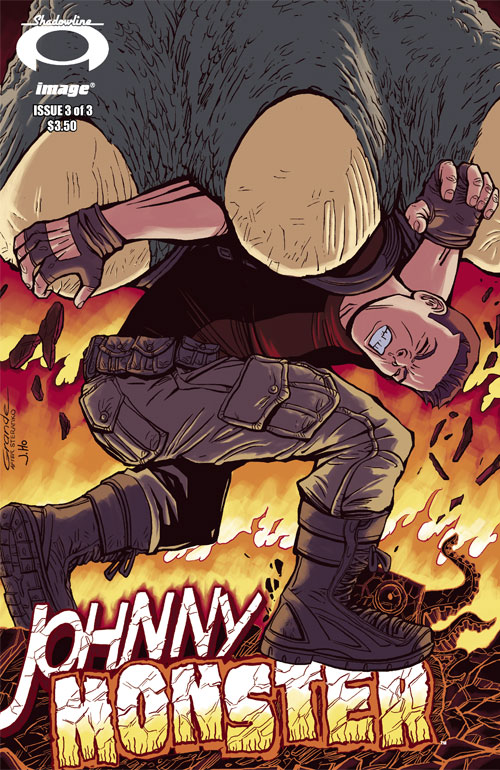 Speaking of The Early Nineties, remember Image Comics back then? Home of spikey violence and questionable plotting? How happy am I that it eventually became this neato home for creator-owned comicing (and they still have a little spikey violence if you like that sort of thing, don't worry). Now you got stuff like Invincible and Killer of Demons and Johnny Monster, which is a fun tale about a guy who fights creatures that resemble Sixties Marvel monsters and who secretly was raised by them and works to keep them safe rather than killing them like his fellow monster hunters. You got monsters and fighting and tentacle beasts and a little moral about communication. I'd check out a second series.
Speaking of The Early Nineties, remember Image Comics back then? Home of spikey violence and questionable plotting? How happy am I that it eventually became this neato home for creator-owned comicing (and they still have a little spikey violence if you like that sort of thing, don't worry). Now you got stuff like Invincible and Killer of Demons and Johnny Monster, which is a fun tale about a guy who fights creatures that resemble Sixties Marvel monsters and who secretly was raised by them and works to keep them safe rather than killing them like his fellow monster hunters. You got monsters and fighting and tentacle beasts and a little moral about communication. I'd check out a second series.
The Strange Adventures of H.P. Lovecraft, Chapter 1
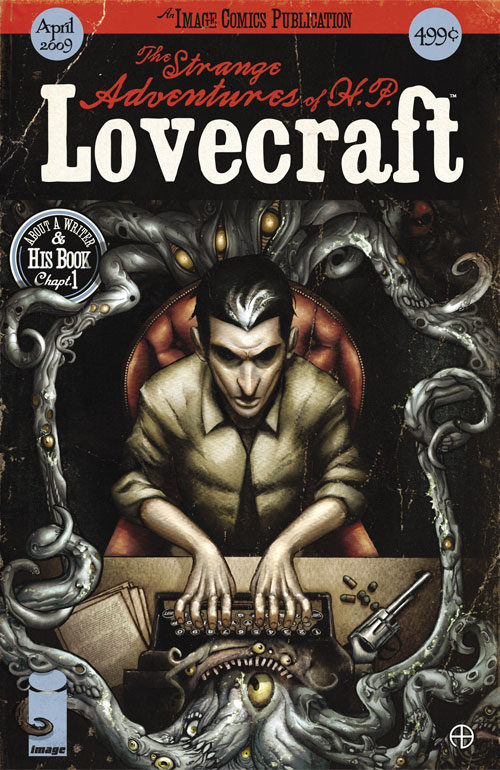 There's an interesting trend in recent years toward writing tales where those who write about the fantastic end up in fantastic adventures themselves. I have a novel somewhere in which Arthur Conan Doyle battles secret cults and Lovecraftian horrors and a few years ago I read a decent little comic about Charles Fort... battling Lovecraftian horrors. Well, now it's Lovecraft's turn to battle his own horrors, which should please Doyle and Fort. And it's good! H.P. is written (by Mac Carter) super-well: he's properly awkward and verbose, he has trouble with women and his aunts are creepy. The art is fantastic - check out the crazy-good, hyper-kinetic scene in the jazz club! Tony Salmans draws the Twenties astonishingly well - he both conveys why flappers are so appealing and that they weren't all ephemeral waifs.
There's an interesting trend in recent years toward writing tales where those who write about the fantastic end up in fantastic adventures themselves. I have a novel somewhere in which Arthur Conan Doyle battles secret cults and Lovecraftian horrors and a few years ago I read a decent little comic about Charles Fort... battling Lovecraftian horrors. Well, now it's Lovecraft's turn to battle his own horrors, which should please Doyle and Fort. And it's good! H.P. is written (by Mac Carter) super-well: he's properly awkward and verbose, he has trouble with women and his aunts are creepy. The art is fantastic - check out the crazy-good, hyper-kinetic scene in the jazz club! Tony Salmans draws the Twenties astonishingly well - he both conveys why flappers are so appealing and that they weren't all ephemeral waifs.
This is a damn good comic, folks. There's plenty for a Lovecraft nerd like me to get all geeky about but it stands up on its own as well - I think that "tentacle monsters vs socially awkward writer in the Twenties" is a pretty universal plot by now, right? There hasn't been too much creepy craziness yet but I'm certain that both the art and the writing are up to the task. And I'm pretty damn pleased that they didn't go the easy route of making Lovecraft a gun-totin' Teddy Roosevelt-esque he-man, as amusing as that might be. Save it for the Robert E Howard comic, guys! Highly recommended - and hey, it's another Image Comic!
Green Lantern Corps No. 35
 More Green Lantern fun. I'm pretty fond of the Corps and now of the Corps-es (and in this series, there are plenty of corpses) - having a superteam where everyone has the same abilities and thus cannot be defined solely by their powers leaves a lot more room for neato personalities. Or for countless weird aliens to bump off in an indiscriminate manner, true, but I think that this series manages to fall somewhere in the middle of that spectrum. The whole buildup to Blackest Night is being handled pretty damn well, I reckon, even though Dan Didio and others have been flinging spoilers to the winds for more than a year (oh look, an ad for Blackest Night toys! And there's a character that hasn't appeared in the comic yet! I sense... a spoiled dramatic reveal!) so it's more like when you watch The Sixth Sense again - you spend a lot of time admiring the mechanics of the storytelling process rather than the story itself. Not that the story isn't great - there's a giant snake in this one! And a dramatic reveal!
More Green Lantern fun. I'm pretty fond of the Corps and now of the Corps-es (and in this series, there are plenty of corpses) - having a superteam where everyone has the same abilities and thus cannot be defined solely by their powers leaves a lot more room for neato personalities. Or for countless weird aliens to bump off in an indiscriminate manner, true, but I think that this series manages to fall somewhere in the middle of that spectrum. The whole buildup to Blackest Night is being handled pretty damn well, I reckon, even though Dan Didio and others have been flinging spoilers to the winds for more than a year (oh look, an ad for Blackest Night toys! And there's a character that hasn't appeared in the comic yet! I sense... a spoiled dramatic reveal!) so it's more like when you watch The Sixth Sense again - you spend a lot of time admiring the mechanics of the storytelling process rather than the story itself. Not that the story isn't great - there's a giant snake in this one! And a dramatic reveal!
R.E.B.E.L.S. No. 3
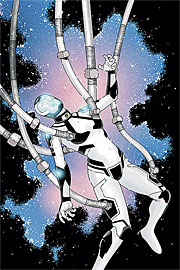 Another story dealing with craziness in DC Outer Space. Vril Dox (aka Brainiac 2) has been ousted from L.E.G.I.O.N. again and is hopping around the universe gathering a team in order to reclaim his robot space police force. He's got a brainfull of information sent into the past by Querl Dox (aka Brainiac 5) in order to ensure that his ancestor lives long enough to spawn a little Brainiac 3 and continue the bloodline, though I thought that that was already taken care of back in the L.E.G.I.O.N '9X days with his dictatorial kid Lyrl Dox. Eh, what do I know. As usual, there are plenty of links to Legion of Super-Heroes future-continuity, now with more justificacation than ever thanks to the aforementioned brainfull of information. And of course he's acting like a total bastard, being Vril Dox. A magnificent bastard!
Another story dealing with craziness in DC Outer Space. Vril Dox (aka Brainiac 2) has been ousted from L.E.G.I.O.N. again and is hopping around the universe gathering a team in order to reclaim his robot space police force. He's got a brainfull of information sent into the past by Querl Dox (aka Brainiac 5) in order to ensure that his ancestor lives long enough to spawn a little Brainiac 3 and continue the bloodline, though I thought that that was already taken care of back in the L.E.G.I.O.N '9X days with his dictatorial kid Lyrl Dox. Eh, what do I know. As usual, there are plenty of links to Legion of Super-Heroes future-continuity, now with more justificacation than ever thanks to the aforementioned brainfull of information. And of course he's acting like a total bastard, being Vril Dox. A magnificent bastard!
Plus: Omega Men, gratuitous robot head smooshing and a dramatic reveal!
Mysterius the Unfathomable No. 4
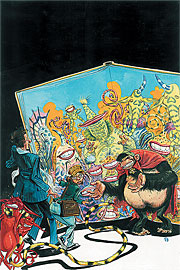 Speaking of bastards, though Mysterius has a more endearing sort of bastardry than Dox does, this series continues to be great. This issue: a really cool new character with a neato history and a smart plan! And not necessarily 100% evil! There's lotsa delicious moral ambiguity in Mysterius - Jeff Parker ain't no Objectivist, that's for sure. Also: "tall and paunchy" and "short and curvy" are underused body types in the funny books. Aw, I won't go on and on about this one - there's a relevant interview just a few posts away, after all. The writing is great, the art is great... definitely a series to check out.
Speaking of bastards, though Mysterius has a more endearing sort of bastardry than Dox does, this series continues to be great. This issue: a really cool new character with a neato history and a smart plan! And not necessarily 100% evil! There's lotsa delicious moral ambiguity in Mysterius - Jeff Parker ain't no Objectivist, that's for sure. Also: "tall and paunchy" and "short and curvy" are underused body types in the funny books. Aw, I won't go on and on about this one - there's a relevant interview just a few posts away, after all. The writing is great, the art is great... definitely a series to check out.
Mini-review: Action Comics No. 876 - good times, still a solid comic. Nightwing and Flamebird were a neat little part of the Silver Age Superman Family and I've been glad to see them return.
Good night.
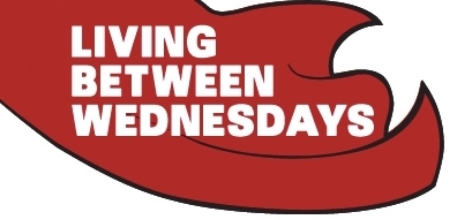
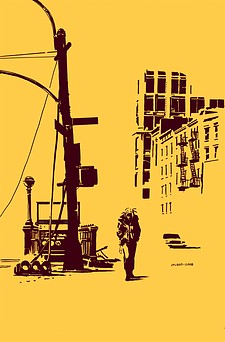
 Hmm. I'm not too sure about this series. I mean, it's basically Oracle vs Calculator, which was among the best subplots of Birds of Prey, but this Oracle isn't quite as interesting. Maybe it's the fact that this is a distinct series - some of the character that was built up over the course of n issues had to be discarded in order to keep people who didn't read those issues but are following Battle for the Cowl in the loop. So Oracle spends some time being stoic about her paralysis and gets mugged and kicks the muggers asses and gets mistaken for an agent of the real/male Oracle. It makes me wish that this were just a crossover sneaking into a series that I read, much as I normally dislike that.
Hmm. I'm not too sure about this series. I mean, it's basically Oracle vs Calculator, which was among the best subplots of Birds of Prey, but this Oracle isn't quite as interesting. Maybe it's the fact that this is a distinct series - some of the character that was built up over the course of n issues had to be discarded in order to keep people who didn't read those issues but are following Battle for the Cowl in the loop. So Oracle spends some time being stoic about her paralysis and gets mugged and kicks the muggers asses and gets mistaken for an agent of the real/male Oracle. It makes me wish that this were just a crossover sneaking into a series that I read, much as I normally dislike that. The Phantom appeals to me in theory: line of adventurers stretching back hundreds of years and doling out justice in a purple union suit, whoopee! So much to read, so little time, though: the only time that I've ever read the Phantom was as a part of a 1980s team called Defenders of the Earth, with Flash Gordon and Mandrake the Magician, I think. Their battle cry wasn't "Liscenced Properties Assemble!" but it should have been.
The Phantom appeals to me in theory: line of adventurers stretching back hundreds of years and doling out justice in a purple union suit, whoopee! So much to read, so little time, though: the only time that I've ever read the Phantom was as a part of a 1980s team called Defenders of the Earth, with Flash Gordon and Mandrake the Magician, I think. Their battle cry wasn't "Liscenced Properties Assemble!" but it should have been. I know next to nothing about American McGee. I don't, for example, know whether he is the one that sticks his name in front of the titles of his projects. Heck, I haven't even played any of his games. Well, we had a copy of American McGee's Alice when I was in university but nobody had a computer that would play it unless we turned the graphics down to Virtua Fighter levels, which detracted from the dark reimagining. Anyway, it's a shame that all I have to judge him by is this comic. Heck, he didn't even write it (unless he is also this "Dwight L. MacPherson", possibly for tax reasons). Bah. I know that it's a tie-in to a video game (to the extent that the Grimm character gets what look to be in-game hints throughout the comic) but that's no excuse. From what I gather, American McGee's Grimm is about taking the happy-go-lucky fairy tales of today back to their gross and violent roots. This is an interesting concept, I admit. BUT! It is neither interesting nor clever to then try to do the same thing to comic books by essentially ignoring anything that has happened artistically or naratively in the last forty years. Grimm drops into a meeting of Sixties-esque villains and makes them dark and spikey and then takes them off to kill super-heroes. That is not subversive, Grimm - that is what we call The Early Nineties. Bah.
I know next to nothing about American McGee. I don't, for example, know whether he is the one that sticks his name in front of the titles of his projects. Heck, I haven't even played any of his games. Well, we had a copy of American McGee's Alice when I was in university but nobody had a computer that would play it unless we turned the graphics down to Virtua Fighter levels, which detracted from the dark reimagining. Anyway, it's a shame that all I have to judge him by is this comic. Heck, he didn't even write it (unless he is also this "Dwight L. MacPherson", possibly for tax reasons). Bah. I know that it's a tie-in to a video game (to the extent that the Grimm character gets what look to be in-game hints throughout the comic) but that's no excuse. From what I gather, American McGee's Grimm is about taking the happy-go-lucky fairy tales of today back to their gross and violent roots. This is an interesting concept, I admit. BUT! It is neither interesting nor clever to then try to do the same thing to comic books by essentially ignoring anything that has happened artistically or naratively in the last forty years. Grimm drops into a meeting of Sixties-esque villains and makes them dark and spikey and then takes them off to kill super-heroes. That is not subversive, Grimm - that is what we call The Early Nineties. Bah. Speaking of The Early Nineties, remember Image Comics back then? Home of spikey violence and questionable plotting? How happy am I that it eventually became this neato home for creator-owned comicing (and they still have a little spikey violence if you like that sort of thing, don't worry). Now you got stuff like Invincible and Killer of Demons and Johnny Monster, which is a fun tale about a guy who fights creatures that resemble Sixties Marvel monsters and who secretly was raised by them and works to keep them safe rather than killing them like his fellow monster hunters. You got monsters and fighting and tentacle beasts and a little moral about communication. I'd check out a second series.
Speaking of The Early Nineties, remember Image Comics back then? Home of spikey violence and questionable plotting? How happy am I that it eventually became this neato home for creator-owned comicing (and they still have a little spikey violence if you like that sort of thing, don't worry). Now you got stuff like Invincible and Killer of Demons and Johnny Monster, which is a fun tale about a guy who fights creatures that resemble Sixties Marvel monsters and who secretly was raised by them and works to keep them safe rather than killing them like his fellow monster hunters. You got monsters and fighting and tentacle beasts and a little moral about communication. I'd check out a second series. There's an interesting trend in recent years toward writing tales where those who write about the fantastic end up in fantastic adventures themselves. I have a novel somewhere in which Arthur Conan Doyle battles secret cults and Lovecraftian horrors and a few years ago I read a decent little comic about Charles Fort... battling Lovecraftian horrors. Well, now it's Lovecraft's turn to battle his own horrors, which should please Doyle and Fort. And it's good! H.P. is written (by Mac Carter) super-well: he's properly awkward and verbose, he has trouble with women and his aunts are creepy. The art is fantastic - check out the crazy-good, hyper-kinetic scene in the jazz club! Tony Salmans draws the Twenties astonishingly well - he both conveys why flappers are so appealing and that they weren't all ephemeral waifs.
There's an interesting trend in recent years toward writing tales where those who write about the fantastic end up in fantastic adventures themselves. I have a novel somewhere in which Arthur Conan Doyle battles secret cults and Lovecraftian horrors and a few years ago I read a decent little comic about Charles Fort... battling Lovecraftian horrors. Well, now it's Lovecraft's turn to battle his own horrors, which should please Doyle and Fort. And it's good! H.P. is written (by Mac Carter) super-well: he's properly awkward and verbose, he has trouble with women and his aunts are creepy. The art is fantastic - check out the crazy-good, hyper-kinetic scene in the jazz club! Tony Salmans draws the Twenties astonishingly well - he both conveys why flappers are so appealing and that they weren't all ephemeral waifs. More Green Lantern fun. I'm pretty fond of the Corps and now of the Corps-es (and in this series, there are plenty of corpses) - having a superteam where everyone has the same abilities and thus cannot be defined solely by their powers leaves a lot more room for neato personalities. Or for countless weird aliens to bump off in an indiscriminate manner, true, but I think that this series manages to fall somewhere in the middle of that spectrum. The whole buildup to Blackest Night is being handled pretty damn well, I reckon, even though Dan Didio and others have been flinging spoilers to the winds for more than a year (oh look, an ad for Blackest Night toys! And there's a character that hasn't appeared in the comic yet! I sense... a spoiled dramatic reveal!) so it's more like when you watch The Sixth Sense again - you spend a lot of time admiring the mechanics of the storytelling process rather than the story itself. Not that the story isn't great - there's a giant snake in this one! And a dramatic reveal!
More Green Lantern fun. I'm pretty fond of the Corps and now of the Corps-es (and in this series, there are plenty of corpses) - having a superteam where everyone has the same abilities and thus cannot be defined solely by their powers leaves a lot more room for neato personalities. Or for countless weird aliens to bump off in an indiscriminate manner, true, but I think that this series manages to fall somewhere in the middle of that spectrum. The whole buildup to Blackest Night is being handled pretty damn well, I reckon, even though Dan Didio and others have been flinging spoilers to the winds for more than a year (oh look, an ad for Blackest Night toys! And there's a character that hasn't appeared in the comic yet! I sense... a spoiled dramatic reveal!) so it's more like when you watch The Sixth Sense again - you spend a lot of time admiring the mechanics of the storytelling process rather than the story itself. Not that the story isn't great - there's a giant snake in this one! And a dramatic reveal! Another story dealing with craziness in DC Outer Space. Vril Dox (aka Brainiac 2) has been ousted from L.E.G.I.O.N. again and is hopping around the universe gathering a team in order to reclaim his robot space police force. He's got a brainfull of information sent into the past by Querl Dox (aka Brainiac 5) in order to ensure that his ancestor lives long enough to spawn a little Brainiac 3 and continue the bloodline, though I thought that that was already taken care of back in the L.E.G.I.O.N '9X days with his dictatorial kid Lyrl Dox. Eh, what do I know. As usual, there are plenty of links to Legion of Super-Heroes future-continuity, now with more justificacation than ever thanks to the aforementioned brainfull of information. And of course he's acting like a total bastard, being Vril Dox. A magnificent bastard!
Another story dealing with craziness in DC Outer Space. Vril Dox (aka Brainiac 2) has been ousted from L.E.G.I.O.N. again and is hopping around the universe gathering a team in order to reclaim his robot space police force. He's got a brainfull of information sent into the past by Querl Dox (aka Brainiac 5) in order to ensure that his ancestor lives long enough to spawn a little Brainiac 3 and continue the bloodline, though I thought that that was already taken care of back in the L.E.G.I.O.N '9X days with his dictatorial kid Lyrl Dox. Eh, what do I know. As usual, there are plenty of links to Legion of Super-Heroes future-continuity, now with more justificacation than ever thanks to the aforementioned brainfull of information. And of course he's acting like a total bastard, being Vril Dox. A magnificent bastard! Speaking of bastards, though Mysterius has a more endearing sort of bastardry than Dox does, this series continues to be great. This issue: a really cool new character with a neato history and a smart plan! And not necessarily 100% evil! There's lotsa delicious moral ambiguity in Mysterius - Jeff Parker ain't no Objectivist, that's for sure. Also: "tall and paunchy" and "short and curvy" are underused body types in the funny books. Aw, I won't go on and on about this one - there's a relevant interview just a few posts away, after all. The writing is great, the art is great... definitely a series to check out.
Speaking of bastards, though Mysterius has a more endearing sort of bastardry than Dox does, this series continues to be great. This issue: a really cool new character with a neato history and a smart plan! And not necessarily 100% evil! There's lotsa delicious moral ambiguity in Mysterius - Jeff Parker ain't no Objectivist, that's for sure. Also: "tall and paunchy" and "short and curvy" are underused body types in the funny books. Aw, I won't go on and on about this one - there's a relevant interview just a few posts away, after all. The writing is great, the art is great... definitely a series to check out.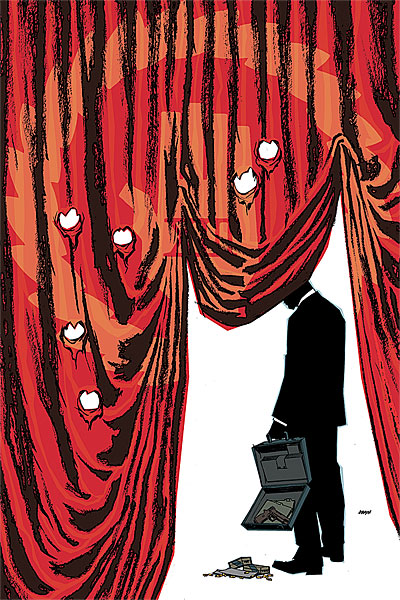


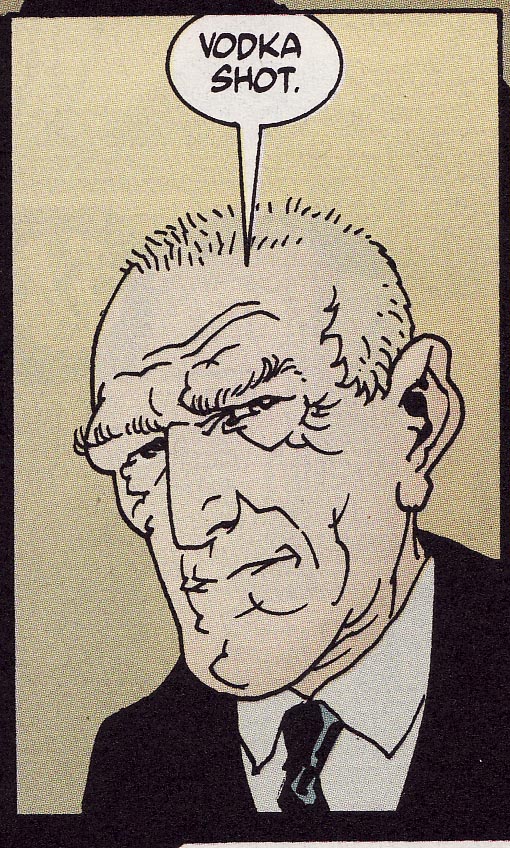

 I'd like to start with you describing the concept of Mysterius the Unfathomable in your own words and where the inspiration came from.
I'd like to start with you describing the concept of Mysterius the Unfathomable in your own words and where the inspiration came from.

